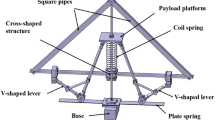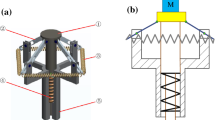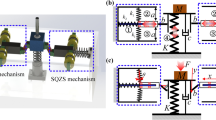Abstract
Nonlinear quasi-zero stiffness (QZS) has recently attracted significant attention from the scientific and engineering community as a method for designing low-frequency vibration isolators. However, previous studies primarily used bistable structures and linear springs to provide negative and positive stiffness, respectively, which limits the QZS range and loading capacity of QZS isolators. This work proposes a novel nonlinear stiffness-modulated anti-vibration structure combined with a disc spring group and a volute spring and demonstrates its feasibility for low-frequency vibration isolation under heavy loads. The asymmetrical negative stiffness provided by the disc spring group and hardened positive stiffness provided by the volute spring compensate each other to construct QZS characteristics. Their nonlinearities can weaken each other, which can lead to a wide QZS range. At the QZS position, the disc springs and the volute spring together provide the positive force, which ensures a large loading capacity. By adjusting the design parameters, different QZS characteristics can be conveniently realized. Compared with traditional QZS structures and typical X-shaped structures, the QZS range of the proposed anti-vibration structure can be, respectively, extended by 2.3 and 1.5 times without sacrificing loading capacity. The dynamic equation is derived from the original nonlinear force expression rather than the typical polynomial approximation expression, which can improve the accuracy of the results, especially under large excitation. The displacement transmissibility obtained by the alternating frequency–time harmonic balance method indicates that the proposed anti-vibration structure exhibits the best vibration isolation performance compared with the linear isolators, traditional QZS isolators, and typical X-shaped isolators. In addition, such a stiffness-modulated anti-vibration structure has a higher sensitivity to damping and a lower sensitivity to base excitation amplitude, which makes it more potential for engineering applications. Besides, the validity of the theoretical analysis is verified by static compression tests and dynamic experiments. This work provides a new method for designing and analysing QZS isolators for heavy-duty low-frequency vibration isolation required in many engineering practices.




























Similar content being viewed by others
Data availability
Not applicable.
References
Li, L., Tan, L., Kong, L., Wang, D., Yang, H.: The influence of flywheel micro vibration on space camera and vibration suppression. Mech Syst Signal Pr 100, 360–370 (2018). https://doi.org/10.1016/j.ymssp.2017.07.029
Sun, X., Zhang, C., Fu, Q., Zhang, H., Dong, H.: Measurement and modeling for harmonic dynamic characteristics of a liquid-filled isolator with a rubber element and high-viscosity silicone oil at low frequency. Mech Syst Signal Pr 140, 106659 (2020). https://doi.org/10.1016/j.ymssp.2020.106659
Li, Y., Xu, D.: Vibration attenuation of high dimensional quasi-zero stiffness floating raft system. Int. J. Mech. Sci. 126, 186–195 (2017). https://doi.org/10.1016/j.ijmecsci.2017.03.029
Jing, X., Zhang, L., Feng, X., Sun, B., Li, Q.: A novel bio-inspired anti-vibration structure for operating hand-held jackhammers. Mech Syst Signal Pr 118, 317–339 (2019). https://doi.org/10.1016/j.ymssp.2018.09.004
Steier, F., Runte, T., Monsky, A., Klock, T., Laduree, G.: Managing the micro-vibration impact on satellite performances. Acta Astronaut. 162, 461–468 (2019). https://doi.org/10.1016/j.actaastro.2019.06.027
Huang, X., Ni, Z., Zhang, Z., Hua, H.: Stiffness optimization of marine propulsion shafting system by FRF-based substructuring method and sensitivity analysis. Ocean Eng. 144, 243–256 (2017). https://doi.org/10.1016/j.oceaneng.2017.08.042
Lu, Z., Wang, Z., Zhou, Y., Lu, X.: Nonlinear dissipative devices in structural vibration control: a review. J. Sound Vib. 423, 18–49 (2018). https://doi.org/10.1016/j.jsv.2018.02.052
Zhao, Y., Meng, G.: A bio-inspired semi-active vibration isolator with variable-stiffness dielectric elastomer: design and modeling. J. Sound Vib. 485, 115592 (2020). https://doi.org/10.1016/j.jsv.2020.115592
Jiang, X., Guo, M., Li, B.: Active control of high-frequency tool-workpiece vibration in micro-grinding. Int. J. Adv. Manuf. Technol. 94(1–4), 1429–1439 (2018). https://doi.org/10.1007/s00170-017-1015-5
Nie, S., Zhuang, Y., Wang, Y., Guo, K.: Velocity & displacement-dependent damper: a novel passive shock absorber inspired by the semi-active control. Mech. Syst. Signal Pr 99, 730–746 (2018). https://doi.org/10.1016/j.ymssp.2017.07.008
Han, W., Lu, Z., Niu, M., Chen, L.: A high-static-low-dynamics stiffness vibration isolator via an elliptical ring. Mech Syst Signal Pr 162, 108061 (2022). https://doi.org/10.1016/j.ymssp.2021.108061
Yan, B., Yu, N., Ma, H., Wu, C.: A theory for bistable vibration isolators. Mech. Syst. Signal Pr 167, 14 (2022). https://doi.org/10.1016/j.ymssp.2021.108507
Lu, Z., Gu, D., Ding, H., Lacarbonara, W., Chen, L.: Nonlinear vibration isolation via a circular ring. Mech. Syst. Signal Pr 136, 106490 (2020). https://doi.org/10.1016/j.ymssp.2019.106490
Jiang, G., Jing, X., Guo, Y.: A novel bio-inspired multi-joint anti-vibration structure and its nonlinear HSLDS properties. Mech. Syst. Signal Pr 138, 106552 (2020). https://doi.org/10.1016/j.ymssp.2019.106552
Shaw, A.D., Gatti, G., Gonçalves, P.J.P., Tang, B., Brennan, M.J.: Design and test of an adjustable quasi-zero stiffness device and its use to suspend masses on a multi-modal structure. Mech. Syst. Signal Pr 152, 107354 (2021). https://doi.org/10.1016/j.ymssp.2020.107354
Zheng, Y., Shangguan, W., Yin, Z., Liu, X.: Design and modeling of a quasi-zero stiffness isolator for different loads. Mech. Syst. Signal Pr 188, 26 (2023). https://doi.org/10.1016/j.ymssp.2022.110017
Zhou, J., Xiao, Q., Xu, D., Ouyang, H., Li, Y.: A novel quasi-zero-stiffness strut and its applications in six-degree-of-freedom vibration isolation platform. J. Sound Vib. 394, 59–74 (2017). https://doi.org/10.1016/j.jsv.2017.01.021
Ibrahim, R.A.: Recent advances in nonlinear passive vibration isolators. J. Sound Vib. 314(3), 371–452 (2008). https://doi.org/10.1016/j.jsv.2008.01.014
Zhao, F., Ji, J., Ye, K., Luo, Q.: An innovative quasi-zero stiffness isolator with three pairs of oblique springs. Int. J. Mech. Sci. 192, 106093 (2021). https://doi.org/10.1016/j.ijmecsci.2020.106093
Zhao, F., Ji, J.C., Ye, K., Luo, Q.: Increase of quasi-zero stiffness region using two pairs of oblique springs. Mech. Syst. Signal Pr 144, 106975 (2020). https://doi.org/10.1016/j.ymssp.2020.106975
Huang, X., Chen, Y., Hua, H., Liu, X., Zhang, Z.: Shock isolation performance of a nonlinear isolator using Euler buckled beam as negative stiffness corrector: Theoretical and experimental study. J. Sound Vib. 345, 178–196 (2015). https://doi.org/10.1016/j.jsv.2015.02.001
Huang, X., Liu, X., Sun, J., Zhang, Z., Hua, H.: Vibration isolation characteristics of a nonlinear isolator using Euler buckled beam as negative stiffness corrector: a theoretical and experimental study. J. Sound Vib. 333(4), 1132–1148 (2014). https://doi.org/10.1016/j.jsv.2013.10.026
Li, M., Cheng, W., Xie, R.: Design and experiments of a quasi–zero-stiffness isolator with a noncircular cam-based negative-stiffness mechanism. J. Vib. Control 26(21–22), 1935–1947 (2020). https://doi.org/10.1177/1077546320908689
Wang, X., Zhou, J., Xu, D., Ouyang, H., Duan, Y.: Force transmissibility of a two-stage vibration isolation system with quasi-zero stiffness. Nonlinear Dynam 87(1), 633–646 (2017). https://doi.org/10.1007/s11071-016-3065-x
Zhou, J., Wang, X., Xu, D., Bishop, S.: Nonlinear dynamic characteristics of a quasi-zero stiffness vibration isolator with cam–roller–spring mechanisms. J. Sound Vib. 346, 53–69 (2015). https://doi.org/10.1016/j.jsv.2015.02.005
Yao, Y., Li, H., Li, Y., Wang, X.: Analytical and experimental investigation of a high-static-low-dynamic stiffness isolator with cam-roller-spring mechanism. Int. J. Mech. Sci. 186, 105888 (2020). https://doi.org/10.1016/j.ijmecsci.2020.105888
Zuo, S., Wang, D., Zhang, Y., Luo, Q.: Design and testing of a parabolic cam-roller quasi-zero-stiffness vibration isolator. Int. J. Mech. Sci. 220, 107146 (2022). https://doi.org/10.1016/j.ijmecsci.2022.107146
Sun, X., Jing, X.: Multi-direction vibration isolation with quasi-zero stiffness by employing geometrical nonlinearity. Mech Syst Signal Pr 62–63, 149–163 (2015). https://doi.org/10.1016/j.ymssp.2015.01.026
Jing, X., Chai, Y., Chao, X., Bian, J.: In-situ adjustable nonlinear passive stiffness using X-shaped mechanisms. Mech Syst Signal Pr 170, 31 (2022). https://doi.org/10.1016/j.ymssp.2021.108267
Jin, G., Wang, Z., Yang, T.: Cascaded quasi-zero stiffness nonlinear low-frequency vibration isolator inspired by human spine. Appl. Math. Mech. 43(6), 813–824 (2022). https://doi.org/10.1007/s10483-022-2852-5
Han, H., Sorokin, V., Tang, L., Cao, D.: A nonlinear vibration isolator with quasi-zero-stiffness inspired by Miura-origami tube. Nonlinear Dynam 105(2), 1313–1325 (2021). https://doi.org/10.1007/s11071-021-06650-6
Wu, J., Che, J., Chen, X., Jiang, W.: Design of a combined magnetic negative stiffness mechanism with high linearity in a wide working region. SCIENCE CHINA Technol. Sci. 65(9), 2127–2142 (2022). https://doi.org/10.1007/s11431-022-2121-7
Jiang, Y., Song, C., Ding, C., Xu, B.: Design of magnetic-air hybrid quasi-zero stiffness vibration isolation system. J. Sound Vib. 477, 115346 (2020). https://doi.org/10.1016/j.jsv.2020.115346
Yan, B., Yu, N., Wang, Z., Wu, C., Wang, S., Zhang, W.: Lever-type quasi-zero stiffness vibration isolator with magnetic spring. J. Sound Vib. 527, 116865 (2022). https://doi.org/10.1016/j.jsv.2022.116865
Zhang, F., Xu, M., Shao, S., Xie, S.: A new high-static-low-dynamic stiffness vibration isolator based on magnetic negative stiffness mechanism employing variable reluctance stress. J. Sound Vib. 476, 115322 (2020). https://doi.org/10.1016/j.jsv.2020.115322
Wang, Q., Zhou, J., Xu, D., Ouyang, H.: Design and experimental investigation of ultra-low frequency vibration isolation during neonatal transport. Mech Syst Signal Pr 139, 106633 (2020). https://doi.org/10.1016/j.ymssp.2020.106633
Ye, K., Ji, J.C.: An origami-inspired quasi-zero stiffness vibration isolator using a novel truss-spring based stack Miura-ori structure. Mech Syst Signal Pr 165, 108383 (2022). https://doi.org/10.1016/j.ymssp.2021.108383
Han, H., Sorokin, V., Tang, L., Cao, D.: Lightweight origami isolators with deployable mechanism and quasi-zero-stiffness property. Aerosp. Sci. Technol. 121, 107319 (2022). https://doi.org/10.1016/j.ast.2021.107319
Liu, S., Peng, G., Jin, K.: Towards accurate modeling of the Tachi-Miura origami in vibration isolation platform with geometric nonlinear stiffness and damping. Appl. Math. Model. 103, 674–695 (2022). https://doi.org/10.1016/j.apm.2021.11.012
Chai, Y., Jing, X.: Low-frequency multi-direction vibration isolation via a new arrangement of the X-shaped linkage mechanism. Nonlinear Dynam 109(4), 2383–2421 (2022). https://doi.org/10.1007/s11071-022-07452-0
Chai, Y., Jing, X., Guo, Y.: A compact X-shaped mechanism based 3-DOF anti-vibration unit with enhanced tunable QZS property. Mech. Syst. Signal Pr 168, 108651 (2022). https://doi.org/10.1016/j.ymssp.2021.108651
Xiong, Y., Li, F., Wang, Y.: A nonlinear quasi-zero-stiffness vibration isolation system with additional X-shaped structure: Theory and experiment. Mech. Syst. Signal Pr 177, 109208 (2022). https://doi.org/10.1016/j.ymssp.2022.109208
Sun, M., Song, G., Li, Y., Huang, Z.: Effect of negative stiffness mechanism in a vibration isolator with asymmetric and high-static-low-dynamic stiffness. Mech. Syst. Signal Pr 124, 388–407 (2019). https://doi.org/10.1016/j.ymssp.2019.01.042
Yan, G., Wu, Z., Wei, X., Wang, S., Zou, H., Zhao, L., Qi, W., Zhang, W.: Nonlinear compensation method for quasi-zero stiffness vibration isolation. J. Sound Vib. 523, 116743 (2022). https://doi.org/10.1016/j.jsv.2021.116743
Yan, G., Qi, W., Shi, J., Yan, H., Zou, H., Zhao, L., Wu, Z., Fang, X., Li, X., Zhang, W.: Bionic paw-inspired structure for vibration isolation with novel nonlinear compensation mechanism. J. Sound Vib. 525, 116799 (2022). https://doi.org/10.1016/j.jsv.2022.116799
Qi, W., Yan, G., Lu, J., Yan, H., Shi, J., Wei, X., Wang, S., Zhang, W.: Magnetically modulated sliding structure for low-frequency vibration isolation. J. Sound Vib. 526, 116819 (2022). https://doi.org/10.1016/j.jsv.2022.116819
Zhao, T., Yan, G., Qi, W., Lu, J., Zhang, W.: Magnetically modulated tetrahedral structure for low-frequency vibration isolation with adjustable load capacity. Int. J. Mech. Sci. 251, 108335 (2023). https://doi.org/10.1016/j.ijmecsci.2023.108335
Chong, X., Wu, Z., Li, F.: Vibration isolation properties of the nonlinear X-combined structure with a high-static and low-dynamic stiffness: Theory and experiment. Mech Syst Signal Pr 179, 109352 (2022). https://doi.org/10.1016/j.ymssp.2022.109352
Chai, Y., Jing, X., Chao, X.: X-shaped mechanism based enhanced tunable QZS property for passive vibration isolation. Int. J. Mech. Sci. 218, 107077 (2022). https://doi.org/10.1016/j.ijmecsci.2022.107077
Moshtaghi Yazdani, N.: Multi-objective optimization of volute springs using an improved NSGA II. Admt Journal 13(4), 13–19 (2020)
Wang, Q., Zhou, J., Wang, K., Lin, Q., Xu, D., Wen, G.: A compact quasi-zero-stiffness device for vibration suppression and energy harvesting. Int. J. Mech. Sci. 250, 108284 (2023). https://doi.org/10.1016/j.ijmecsci.2023.108284
Chen, S., Xuan, M., Xin, J., Liu, Y., Gu, S., Li, J., Zhang, L.: Design and experiment of dual micro-vibration isolation system for optical satellite flywheel. Int. J. Mech. Sci. 179, 105592 (2020). https://doi.org/10.1016/j.ijmecsci.2020.105592
Mao, J., Hao, Z., Jing, G., Zheng, X., Liu, C.: Sound quality improvement for a four-cylinder diesel engine by the block structure optimization. Appl. Acoust. 74(1), 150–159 (2013). https://doi.org/10.1016/j.apacoust.2012.07.005
Yu, C., Fu, Q., Zhang, J., Zhang, N.: The vibration isolation characteristics of torsion bar spring with negative stiffness structure. Mech Syst Signal Pr 180, 109378 (2022). https://doi.org/10.1016/j.ymssp.2022.109378
Chen, R., Li, X., Yang, Z., Xu, J., Yang, H.: A variable positive-negative stiffness joint with low frequency vibration isolation performance. Measurement 185, 110046 (2021). https://doi.org/10.1016/j.measurement.2021.110046
Chen, R., Li, X., Tian, J., Yang, Z., Xu, J.: On the displacement transferability of variable stiffness multi-directional low frequency vibration isolation joint. Appl. Math. Model. 112, 690–707 (2022). https://doi.org/10.1016/j.apm.2022.08.021
Zhou, Y., Chen, P.: Investigations on a vertical isolation system with quasi-zero stiffness property. Smart Struct. Syst. 25(5), 15 (2020). https://doi.org/10.12989/sss.2020.25.5.543
Meng, L., Sun, J., Wu, W.: Theoretical design and characteristics analysis of a quasi-zero stiffness isolator using a disk spring as negative stiffness element. Shock. Vib. 2015, 1–19 (2015). https://doi.org/10.1155/2015/813763
Liu, Y., Ji, W., Gu, H., Deng, E., Wang, X., Song, C.: Force transmissibility of a 6-DOF passive quasi-zero stiffness vibration isolation platform. J. Mech. Sci. Technol. 35(6), 2313–2324 (2021). https://doi.org/10.1007/s12206-021-0504-5
Almen, J.O.: The Uniform-Section Disk Spring. Trans Asme 58(4), 305–314 (1936)
Wahl, A.M.: Mechanical springs. McGraw-Hill, New York (1963)
Ozaki, S., Tsuda, K., Tominaga, J.: Analyses of static and dynamic behavior of coned disk springs: effects of friction boundaries. Thin Wall Struct 59, 132–143 (2012). https://doi.org/10.1016/j.tws.2012.06.001
Krack, M., Gross, J.: Harmonic Balance for Nonlinear Vibration Problems, 1st edn. Springer International Publishing, Switzerland, Cham (2019)
Funding
The authors gratefully acknowledge the support by the National Natural Science Foundation of China (Grant No. 52275092).
Author information
Authors and Affiliations
Contributions
All authors contributed to the study conception and design. Material preparation, data collection and analysis were performed by Kangfan Yu, Yunwei Chen and Chuanyun Yu. The first draft of the manuscript was written by Kangfan Yu, and all authors commented on previous versions of the manuscript. All authors read and approved the final manuscript.
Corresponding author
Ethics declarations
Conflict of interest
Kangfan Yu, Yunwei Chen, Chuanyun Yu, Jianrun Zhang and Xi Lu declare that they have no conflict of interest or financial conflicts to disclose.
Additional information
Publisher's Note
Springer Nature remains neutral with regard to jurisdictional claims in published maps and institutional affiliations.
Rights and permissions
Springer Nature or its licensor (e.g. a society or other partner) holds exclusive rights to this article under a publishing agreement with the author(s) or other rightsholder(s); author self-archiving of the accepted manuscript version of this article is solely governed by the terms of such publishing agreement and applicable law.
About this article
Cite this article
Yu, K., Chen, Y., Yu, C. et al. A compact nonlinear stiffness-modulated structure for low-frequency vibration isolation under heavy loads. Nonlinear Dyn 112, 5863–5893 (2024). https://doi.org/10.1007/s11071-024-09334-z
Received:
Accepted:
Published:
Issue Date:
DOI: https://doi.org/10.1007/s11071-024-09334-z




